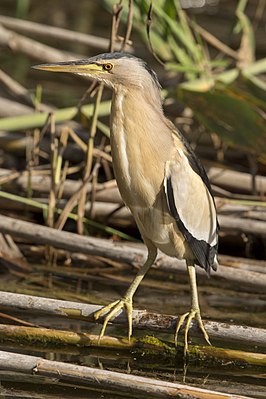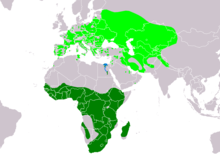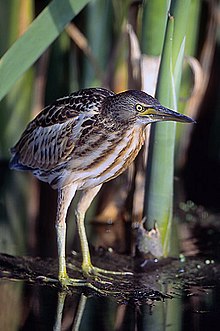Little bittern
| Little bittern | ||||||||||||
|---|---|---|---|---|---|---|---|---|---|---|---|---|

Little bittern, young bird |
||||||||||||
| Systematics | ||||||||||||
|
||||||||||||
| Scientific name | ||||||||||||
| Ixobrychus minutus | ||||||||||||
| ( Linnaeus , 1766) |
The little bittern ( Ixobrychus minutus ) is a hidden bird of extensive reed beds from the heron family (Ardeidae).
Appearance
The little bittern is about 27 to 36 centimeters tall and roughly the same as a jay . This makes it the smallest species of heron found in Central Europe. The back, shoulders and tail of the male bird are greenish-black plumage. On the neck, on the chest and on the rest of the underside of the body, the plumage is yellowish in color. The female has a similar plumage, but it is less contrasting. The back and shoulders do not show the contrasting greenish-black of the male, but rather a dark brown, just as the neck, chest side and flanks are more brownish. In flight, the neck is curved in an S-shape. Young birds have light and dark spotted plumage and their backs are brownish.
distribution

Bittern live in parts of Europe , western Asia and in Africa south of the Sahara. As migratory birds, they are so-called long-distance migrants, because populations breeding in Europe migrate to southern Africa to winter.
habitat
The bittern habitat includes freshwater swamps, alluvial forests , peat bogs, abandoned clay pits and similar habitats with dense vegetation and tall reeds. It breeds there mainly in the siltation zone.
Way of life
The little bittern is a shy bird that is active during the day and at dusk. He does not like to fly up, then usually brushes low over the reeds and usually falls back into cover after a short flight distance. Usually, like the bittern, when disturbed it freezes in a post position in which the camouflage of the reed-yellow and brown-dashed breast comes into play.
Little bitterns eat fish, insects, frogs and tadpoles, as well as worms and mollusks. They prey on them by slowly climbing through the reeds or waiting motionless for a prey to show itself.
Hazard and inventory situation
The Little Bittern is listed on the Red List of Endangered Species by the IUCN, the World Conservation Union . Despite the obvious decline in the population, it describes the worldwide situation of the species as not endangered ( Least Concern ). The extremely large distribution area, the assumed slow population decline with an overall extensive population speak against a higher risk categorization. In general, large population fluctuations are typical for this species, but little is known about their cause. Since the late 1960s, the little bittern has partly completely disappeared in many breeding areas without any noticeable changes in habitat. Since there are comparable populations of long-distance migrants such as the purple heron , night heron , sand martin and redstart , which, like the little bittern, cross large desert areas and rest or winter in the Sahel zone, it is possible that the decline is a result of years of drought in Africa. Among other things, Lake Chad dried up temporarily. In Africa there is also a strong loss of habitat due to the intensification of agriculture.
The stock situation of the little bittern in Central Europe is worrying. In the red list of breeding birds in Germany, the species is listed in category 2 (“endangered”). The breeding population was estimated at only 460 pairs in 1985, but they lived so isolated from each other that mutual exchange is probably no longer possible. For 2005 to 2009 the number of breeding pairs is given as 220 to 290. In Switzerland , the breeding population was estimated at 45 pairs in the 1980s. The main area of distribution in Central Europe is Hungary, where between 4,000 and 6,000 breeding pairs occur in 1998.
The main cause of the decline is the loss of suitable habitats. Both wetlands and reed stocks have either been destroyed or are subject to such high levels of disturbance from water sports, bathers and anglers that they are no longer accepted as a breeding area by the little bittern.
The species belongs to Appendix I of the EU Birds Directive (RL 79/409 / EEC). Bird protection areas are to be designated for them in the European Union.
literature
- Hans-Günther Bauer, Einhard Bezzel and Wolfgang Fiedler (eds.): The compendium of birds in Central Europe: Everything about biology, endangerment and protection. Volume 1: Nonpasseriformes - non-sparrow birds , Aula-Verlag Wiebelsheim, Wiesbaden 2005, ISBN 3-89104-647-2 .
- James A. Kushlan & James A. Hancock: Herons . Oxford University Press, 2005, ISBN 0-19-854981-4 .
Web links
- Videos, photos and sound recordings for Ixobrychus minutus in the Internet Bird Collection
- Age and gender characteristics (PDF; 1.6 MB) by J. Blasco-Zumeta and G.-M. Heinze (eng.)
- Little bittern feathers
Individual evidence
- ↑ Ixobrychus minutus in the endangered Red List species the IUCN 2009. Posted by: BirdLife International, 2009. Accessed on March 10 of 2010.
- ↑ Bauer et al., P. 252
- ↑ Bauer et al., P. 253
- ↑ Christoph Grüneberg, Hans-Günther Bauer, Heiko Haupt, Ommo Hüppop, Torsten Ryslavy, Peter Südbeck: Red List of Germany's Breeding Birds , 5 version . In: German Council for Bird Protection (Hrsg.): Reports on bird protection . tape 52 , November 30, 2015.
- ↑ Christoph Grüneberg, Hans-Günther Bauer, Heiko Haupt, Ommo Hüppop, Torsten Ryslavy & Peter Südbeck: Red List of Germany's Breeding Birds , 5th version, November 30, 2015 . In: Reports on bird protection . tape 52 , 2015, p. 19-67 .
- ↑ Bauer et al., P. 253



